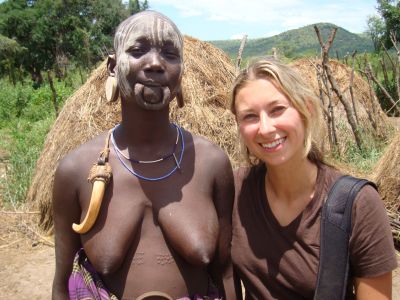One of the girls in Southern Ethiopia
In a tiny village in southern Ethiopia, somewhere in the Lower Omo Valley’s Mago National Park, a group of Mursi women prepare for a day of visitors. Though they’re cattle herders by tradition, tourism is now their main form of income. They baste themselves with white body paint, designing lines with the scratch of a fingernail. Their arms are adorned with jingling brass bracelets, their mouths are wrapped around coaster-sized lip plates. Worn in the lower lip, the clay plate has become the defining image of the Mursi woman. The process involves piercing a hole in the bottom lip, stretching it out and gradually increasing the size of the lip plate.
The Mursi see it as a symbol of a woman’s beauty, pride and sexual maturity.
When the lip isn’t spooled around the plate, it dangles below the chin like Buddha’s ear lobes. For the foreigner who’s just been introduced to this unusual cultural practice, it’s hard to imagine how the women can comfortably eat, drink or speak.
Curious about how lip plates are made, I’m happy when the chief’s wife agrees to show me. Sitting cross-legged on the dirt floor outside her thatched hut, she gives me a silver mixing bowl and a handful of moist grey clay.
In principle, the process of making a lip plate seemed simple enough: Take a clump of mud, mould it into the shape of a hockey puck and bake it in the hot sun. In practice, it’s a bit more difficult. I dip my fingers in a pool of muddy water and knead the clay like it’s cookie dough. The chief’s wife chuckles at my poor pottery-making abilities.
I sneak a peek at the many Mursi women who have gathered around us. As they make their own lip plates, there’s a hum of chatter. A woman gossips, a baby cries, a mother scolds.
Through an interpreter, I ask if a farenji (foreigner) can also wear a lip plate. “Can you give me one?” I ask jokingly, offering my lip for incision. They laugh. They don’t think it’s a good look for me. Someone hands the chief’s wife a giant knife and she calls my bluff. “No, no, no,” I jabber nervously as the Mursi women howl with laughter.
The moment feels almost sacred; a deep, sense of connection washes over me. Though we come from different cultures, though we have different traditions and different concepts of beauty, we share the universality of laughter, of human experience, of womanhood. I feel just like one of the girls. This article was first published in Metro metronews.ca For more by Julia Dimon visit thetraveljunkie.ca or juliadimon.com
< back to the episode
< back to the list of articles |

